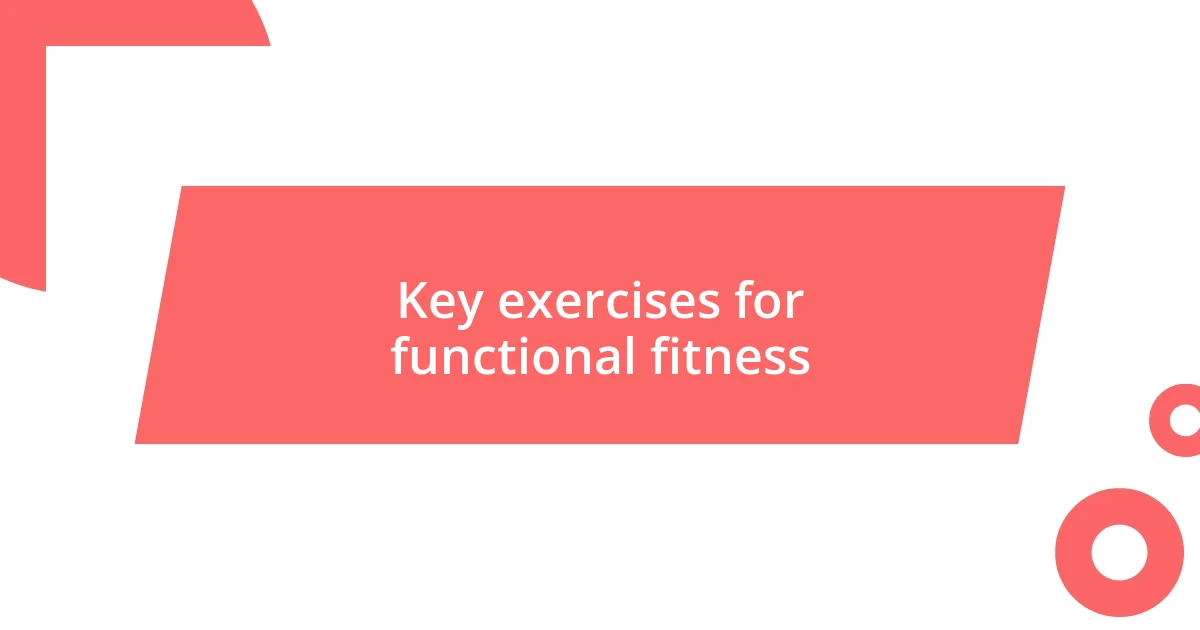Key takeaways:
- Functional fitness enhances everyday movement, making daily tasks easier and more enjoyable through exercises that improve strength, balance, and coordination.
- Tracking progress fosters motivation and self-discovery, with each small victory contributing to overall growth and empowerment in the fitness journey.
- Setting realistic goals, maintaining consistency, and finding a supportive community are essential for long-term success in functional fitness.

Introduction to functional fitness
Functional fitness is about exercising in ways that mirror everyday activities, enhancing your ability to perform daily tasks effortlessly. I remember the first time I lifted a heavy grocery bag after starting my functional fitness journey; it felt like a victory that was more than just physical strength—it was empowerment. Doesn’t it feel great when you realize your workout translates directly into your real life?
This approach goes beyond aesthetics; it emphasizes movement patterns that improve coordination, balance, and strength. I find it fascinating how activities like squatting to pick something up or reaching overhead aren’t just mundane tasks, but opportunities to elevate our physical capabilities. Have you ever paused to think about how functional fitness can make those tasks less daunting and more enjoyable?
At its core, functional fitness teaches us to support our bodies in a holistic way. It’s invigorating to be part of a community that shares this mindset, where every workout feels like a celebration of what our bodies can do. One of my proudest moments came during a group session when we tackled a challenging obstacle course together; the support and encouragement among us transformed a simple workout into an unforgettable experience. Isn’t that what fitness should be about—connecting and growing stronger together?

My initial fitness challenges
In the beginning, my relationship with fitness felt somewhat tentative. I often struggled with basic movements; squatting was a challenge, and lifting my own body weight felt like an insurmountable task. I still recall the embarrassment I felt during my first group class, where I couldn’t keep up with the more experienced participants.
As I navigated through those initial hurdles, I learned a lot about my limits. The realization struck me—not everyone starts as an athlete, and that’s perfectly okay. I found that instead of comparing myself to others, focusing on my own progress became my north star. Each small victory, whether it was completing an extra rep or mastering a new technique, fueled my motivation and boosted my confidence.
Over time, my efforts started to bear fruit, and that shift was incredibly empowering. I vividly remember the first time I successfully balanced on one leg during a workout; it was a simple act, but to me, it represented a significant leap in my journey. Embracing these early challenges transformed my fitness approach into something more meaningful than just physical exertion—it became a personal journey of self-discovery and resilience.
| Initial Challenge | Emotional Impact |
|---|---|
| Struggling with basic movements | Feelings of embarrassment and frustration |
| Navigation of limits | Growth in motivation and self-acceptance |
| First achievement in balance | Incredible sense of empowerment |

Discovering functional fitness concepts
Functional fitness concepts first caught my attention when I realized how seamlessly they integrated into my daily life. I remember one afternoon, rushing to catch a bus and lugging my backpack, I instinctively squatted down to tie my shoelaces. That moment felt different; I was grounded, strong, and aware of my body’s capabilities. It struck me that this wasn’t just working out—it was about preparing my body for life’s demands.
Here’s what I’ve come to understand about functional fitness:
- Multipurpose Movements: Exercises like deadlifts and lunges mimic actions we perform daily.
- Muscle Memory Enhancement: Repeating these functional movements helps the body remember how to move efficiently during everyday tasks.
- Balance and Stability: Strengthening the core through functional fitness can prevent falls and improve overall stability.
- Community Connection: Training in groups fosters camaraderie, amplifying motivation and accountability, which I truly value.
Reflecting on my journey, what resonates most is how adaptive these concepts are to various lifestyles and fitness levels. The beauty lies in discovering exercises that accommodate different needs but are equally empowering. There’s a sense of solidarity, knowing that we’re all in this together, each movement a step toward shared progress.

Key exercises for functional fitness
When it comes to key exercises for functional fitness, I can’t help but highlight the squat. Not only does it engage your legs and core, but it also closely mimics daily activities, like bending down to pick something up. The first time I increased my squat weight, I felt a rush of excitement—suddenly, lifting groceries felt like a breeze!
Another essential exercise I swear by is the plank. In my early days, holding a plank felt like an eternity, and I’d often find myself twitching in effort. But I quickly realized how it builds core strength, which is vital for stability in everyday movements. Have you ever considered how much easier it is to stand up from a chair when your core is strong? That’s functional fitness in action!
Then there are movements like kettlebell swings, which really encapsulate the beauty of functional training. They engage multiple muscle groups while improving cardiovascular endurance. I remember one morning, swinging the kettlebell felt more fluid than it ever had, and it struck me—this was not just a workout; it was preparing me for life’s physical challenges, such as playing with my kids or hiking without feeling exhausted. Each exercise becomes a building block, enhancing both my strength and confidence day by day.

Creating my functional fitness routine
Creating my functional fitness routine has been an evolving process, fueled by trial and error. I remember when I first decided to structure my workouts, I felt overwhelmed. There are so many exercises to choose from! Would I even enjoy them? Ultimately, I focused on movements that felt natural and enjoyable to me. Incorporating squats and lunges, I quickly realized that every rep was like training for the everyday tasks I faced, such as lifting my toddler or carrying groceries up the stairs.
Finding a rhythm in my routine took some time, but I also embraced variety. I recall one particular week when I added kettlebell swings to my regimen. The first few attempts were shaky, but after some practice, I could feel my coordination improve. Every swing became less about the gym and more about enhancing my ability to play outside with my kids. I can still vividly picture the joy on their faces as I swung the kettlebell like a pro—pretty rewarding, right?
Balance has become a key part of my routine as well. I remember nervously stepping onto a balance board for the first time. At first, I felt unsteady and anxious, but with each session, I noticed my confidence building. Now, it’s not just about physical strength; it’s about cultivating resilience. Weakness transformed into empowerment, and I started to appreciate how creating my own routine not only nurtured my body but also forged a stronger connection to my overall wellness. Isn’t that what we all strive for—a sense of balance in both fitness and life?

Tracking my progress and results
Tracking my progress has been an enlightening journey. I started by taking weekly photos and jotting down my workout results. It’s fascinating to look back and see how far I’ve come—those early photos, the awkward positions, and the uncertain smiles. Have you ever felt that pride when you realize how much you’ve changed? Every time I compared my current self to those initial snapshots, it fueled my motivation.
Incorporating a fitness journal was a game-changer for me. I would write about my challenges and triumphs after every workout. I vividly remember a day when I finally managed to complete my first unassisted pull-up. I almost jumped for joy! Tracking that moment in my journal made it clear that progress isn’t just about numbers; it’s about experiences and growth. How do you celebrate your milestones? I believe it’s crucial to acknowledge every step, no matter how small, because they all contribute to a more robust version of ourselves.
I also began using fitness apps that helped me log my workouts and set new goals. At first, I didn’t think I’d find them useful, but they transformed my approach. I could see my stats improve—once daunting weights melted away into manageable challenges. There was a moment when I hit a new personal best for my kettlebell swings, and I couldn’t help but smile. Those little achievements highlighted how tracking my progress isn’t just a way to measure fitness; it’s a reminder of the journey I’m on. It’s about making a commitment to myself and celebrating the victories along the way. What better way to stay inspired than to witness your own evolution?

Tips for long-term success
One of the most effective tips for long-term success in functional fitness is setting realistic goals. I once aimed to achieve a certain fitness level by a specific date, but that pressure only led to frustration. Now, I break my larger goals into smaller, achievable milestones. Have you ever noticed how celebrating these little victories can boost your confidence? For example, mastering a new movement or simply increasing your reps brings a sense of accomplishment that keeps the momentum going.
Consistency is key, and I learned this firsthand. There were days when I felt too tired or unmotivated to hit the gym. Instead of pushing myself too hard, I started committing to shorter, more focused sessions. I remember one rainy afternoon when I only had 15 minutes to spare. I did a quick circuit of bodyweight exercises in my living room, and by the end, I felt invigorated. Sometimes, even a little effort can make a significant difference. Have you ever found that your best workouts happen when you let go of perfection?
Finally, finding a supportive community has been invaluable in my fitness journey. I joined a local group where we shared our struggles and successes. I vividly recall the first time I attended a group workout; I was nervous but welcomed with open arms. Connecting with others who share similar goals has made the process so much more enjoyable. Have you ever felt that rush of motivation from working alongside others? I can confidently say that when we share our journeys, we inspire one another to strive for better outcomes.















